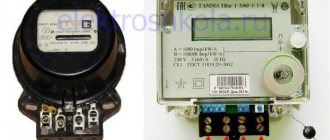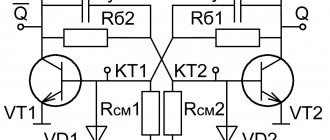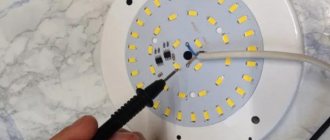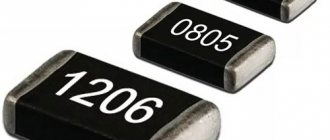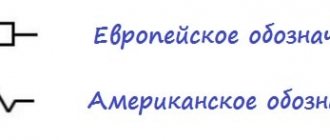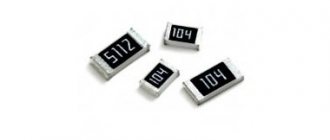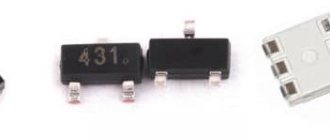The values of commercially produced electronic components (resistor values, capacitor values, inductance of small inductors) are not arbitrary. There are special series of denominations established by the standard,[1] representing sets of values from 1 to 10. The denomination of a part of a certain series is some value from the corresponding series, multiplied by an arbitrary decimal factor (10 to the integer power). For example: resistor from the E12
may have one of the following ratings (resistances):
- 1,2
- 12 ohm
- 120 Ohm
- …
- 1.2 MOhm
- 12 MOhm
Nominal series E6, E12 and E24
The name of the series indicates the total number of elements in it, that is, series E24 contains 24 numbers in the range from 1 to 10, E12 - 12 numbers, etc.
Each row corresponds to a certain tolerance in the part ratings. Thus, parts from the E6 series have a permissible deviation from the nominal value of ±20%, from the E12 series - ±10%, from the E24 series - ±5%. Actually, the rows are arranged in such a way that the next value differs from the previous one by slightly less than double tolerance.
The nominal values for some rows are given in the table:
Nominal rows E3, E6, E12, E24
| E3 | E6 | E12 | E24 | E3 | E6 | E12 | E24 | E3 | E6 | E12 | E24 | ||
| 1,0 | 1,0 | 1,0 | 1,0 | 2,2 | 2,2 | 2,2 | 2,2 | 4,7 | 4,7 | 4,7 | 4,7 | ||
| 1,1 | 2,4 | 5,1 | |||||||||||
| 1,2 | 1,2 | 2,7 | 2,7 | 5,6 | 5,6 | ||||||||
| 1,3 | 3,0 | 6,2 | |||||||||||
| 1,5 | 1,5 | 1,5 | 3,3 | 3,3 | 3,3 | 6,8 | 6,8 | 6,8 | |||||
| 1,6 | 3,6 | 7,5 | |||||||||||
| 1,8 | 1,8 | 3,9 | 3,9 | 8,2 | 8,2 | ||||||||
| 2,0 | 4,3 | 9,1 |
It can be seen that the E12 series is obtained by deleting every second denomination from the E24 series, similarly, E6 is obtained by deleting every second denomination from E12.
Marking of SMD resistors
In modern electronics, one of the key factors when developing a device is its miniaturization. This causes the creation of leadless elements. SMD components are small in size due to their leadless design. Don't be confused by this installation method, it is used in most modern electronics and is characterized by good reliability. In addition, this simplifies the design of a multilayer printed circuit board. The literal decoding with translation means “surface mount device”, and they are mounted on the surface of a printed circuit board. Due to their miniature size, there are difficulties in marking their denomination and characteristics on the case, so they compromise and use marking methods by numbers, with letters, or using a code system. Let's figure out how SMD resistors are marked.
If there are 3 digits on the SMD resistor, then the decoding is as follows: XYZ, where X and Y are the first two digits of the nominal value, and Z is the number of zeros. Let's look at an example.
It is possible to designate it with 4 digits, then everything is the same, only the first three digits are hundreds, tens and units, and the last one is zeros.
If letters are entered into the marking, then the decoding is similar to domestic MLT resistors.
And integers are separated from fractional values.
Another thing is when alphanumeric encoding is used, such resistors have to be deciphered using tables.
In this case, the letter denotes the multiplier. In the table below, they are circled in red.
Based on the table, code 01C means:
- 01 = 100 Ohm;
- C – multiplier 102, this is 100;
- 100*100 = 10000 Ohm or 10 kOhm.
This designation option is called EIA-96.
The information contained in symbolic or color coding will help you build circuits with high accuracy and use elements with the appropriate ratings and tolerances. Correct understanding of the symbols will not relieve you of the need to measure resistances. It is still better to check it again, because the element may be faulty. The test can be done with a special ohmmeter or multimeter. We hope that the information provided about what resistor markings are and how they are deciphered was useful and interesting for you!
Related materials:
- How to test a resistor at home
- Wire color coding
- How to determine the capacitance of a capacitor
- How to properly desolder radio components from boards
Principles of constructing series
The series E24 is approximately a geometric progression with a denominator of 101/24. In other words, on a logarithmic scale, the elements of this series divide the segment from 1 to 10 into 24 equal parts. For some apparently historical reasons, some elements differ from the ideal progression, although never by more than 5%. Nominal series with fewer elements are obtained by deleting elements from the E24 series one by one. The denominations from these series form an approximately geometric progression with the denominator 101/12 (E12), 101/6 (E6), 101/3 (E3). The E3 series is practically not used. Nominal series with a large number of elements form an absolutely exact geometric progression with a denominator of 101/ n
, where
n
is the number of elements of the series.
The number n
is always a power of 2 times 3.
The nominal series is essentially a table of decimal logarithms. Indeed, the ordinal number of the element in the series minus 1 gives the mantissa of the logarithm in the form of a simple fraction with a denominator ( m
− 1)/
n
(
m
is the number of the element,
n
is the order of the row, for example, 24 for E24). Knowing the series E24 by heart, you can thus mentally calculate products of numbers, roots of small powers of numbers, logarithms of numbers with an accuracy of approximately ±5%. For example, let's calculate the square root of 1000. The decimal logarithm of this number is 3, dividing it in half, we find that the decimal logarithm of the answer is 1.5 = 1 + 12/24, i.e. the answer is 10 times the element in the row E24 in 13th place, i.e. exactly in the middle of the row, i.e. we got about 33.
There is a universal way to determine the denomination for any series:
V(n) = 10^{n/N} = \exp \left( \frac{n}{N} \cdot \ln 10 \right),
where N is the row number (3, 6, 12, 24, etc.), and n = 0, 1, 2, …, (n) means the serial number of the denomination in the row.[2].
Color coding of resistors
Often, resistors are very small elements that cannot be labeled. That's probably why they invented color coding. Well, and another way to explain it is that the colors are international. So there is no need to think about the country of origin and keep the specifics in mind. If you understand the principle, this marking of resistors will not confuse you either.
Color coding of resistors: number of strips and the meaning of their location
Let's figure out what the colored stripes on the resistor body mean. There can be three, four, five or six stripes. The first two or three are meaningful data, that is, numbers are encoded under the colors. It is by them that the denomination is determined. After them there is a strip by which the multiplier is determined. This is often (but not always) followed by a gap - a much greater distance than there was between the rings before. The stripes applied after this empty space are the tolerance and temperature coefficient. Moreover, the temperature coefficient is only available with six-element color coding, since only high-precision elements are encrypted with such a “wide” code. In the rest it is simply not indicated. That's all the color coding of resistors.
To determine the resistance value, you need to know which number corresponds to each color. If these are significant figures, the match is the same. It is presented in the table.
What do the colored rings on a resistor mean?
Separately, you just need to remember the value of the multiplier and tolerance, as well as the temperature coefficient
But the last two points, as a rule, are not always taken into account, so it is enough to remember only two columns of the table above
Examples of reading color codes on resistors
For example, let's take several color-coded resistors.
Example 1. In the first picture (see below) there are five stripes, one of them is applied through the indentation - this is exactly the tolerance. The color of this ring is red, which corresponds to an error of 1% of the nominal value. Let's look at the remaining bands - these are significant numbers and a multiplier. Let's look at the table:
- first - red - 2
- second - black - 0
- third - black - 0
- fourth - brown - 10 Ohm multiplier.
So we get: 200 must be multiplied by 10 Ohms. It turns out 2000 Ohm or 2 kOhm. The tolerance was determined earlier and it is equal to 2%.
How to decipher stripes on resistors
Example 2. The second picture contains six stripes. The first four are about the rating and multiplier, the fifth is the tolerance and the sixth is the temperature coefficient of resistance (how much the resistance changes when heated).
Let's look at the denomination:
- first - brown - 1;
- second - black - 0;
- third - black - 0;
- multiplier - red 100 Ohm;
We get that 100 must be multiplied by 100 Ohms. Total: 100*100 Ohm = 10,000 Ohm or 10 kOhm.
Example 3. Let's immediately begin determining the denomination.
- first - red - 2;
- second - black - 0;
- the third - red - multiplier - 100 Ohms.
Why was the third digit defined as a multiplier? Because in the marking the last two digits (if there are less than six) are the multiplier and the tolerance. In this case, we get: 20 * 100 Ohm = 2000 Ohm or 2 kOhm. Permissible deviations of the nominal value - yellow - 0.2%.
Two more examples
Example 4. There are only three stripes on the resistor. This is how resistors with possible deviations from the nominal value of up to 20% are marked. All three stripes are used to decipher the denomination. The first two are numbers, the third is a multiplier.
- first - red - 2;
- second - black - 0;
- third - multiplier - brown - 10 Ohms.
In total we get the nominal value: 20 * 10 Ohm = 200 Ohm with a permissible deviation of 20%.
Nominal series with a large number of elements
The E48 series corresponds to a relative accuracy of ±2%, E96 - ±1%, E192 - ±0.5%.
The elements of these series form a geometric progression with denominators 101/48 ≈ 1.04914, 101/96 ≈ 1.024275, 101/192 ≈ 1.01206483 and can be calculated on a calculator. Nominal series E48, E96, E192
| E48 | E96 | E192 | E48 | E96 | E192 | E48 | E96 | E192 | E48 | E96 | E192 | E48 | E96 | E192 | E48 | E96 | E192 | |||||
| 1,00 | 1,00 | 1,00 | 1,47 | 1,47 | 1,47 | 2,15 | 2,15 | 2,15 | 3,16 | 3,16 | 3,16 | 4,64 | 4,64 | 4,64 | 6,81 | 6,81 | 6,81 | |||||
| 1,01 | 1,49 | 2,18 | 3,20 | 4,70 | 6,90 | |||||||||||||||||
| 1,02 | 1,02 | 1,50 | 1,50 | 2,21 | 2,21 | 3,24 | 3,24 | 4,75 | 4,75 | 6,98 | 6,98 | |||||||||||
| 1,04 | 1,52 | 2,23 | 3,28 | 4,81 | 7,06 | |||||||||||||||||
| 1,05 | 1,05 | 1,05 | 1,54 | 1,54 | 1,54 | 2,26 | 2,26 | 2,26 | 3,32 | 3,32 | 3,32 | 4,87 | 4,87 | 4,87 | 7,15 | 7,15 | 7,15 | |||||
| 1,06 | 1,56 | 2,29 | 3,36 | 4,93 | 7,23 | |||||||||||||||||
| 1,07 | 1,07 | 1,58 | 1,58 | 2,32 | 2,32 | 3,40 | 3,40 | 4,99 | 4,99 | 7,32 | 7,32 | |||||||||||
| 1,09 | 1,60 | 2,34 | 3,44 | 5,05 | 7,41 | |||||||||||||||||
| 1,10 | 1,10 | 1,10 | 1,62 | 1,62 | 1,62 | 2,37 | 2,37 | 2,37 | 3,48 | 3,48 | 3,48 | 5,11 | 5,11 | 5,11 | 7,50 | 7,50 | 7,50 | |||||
| 1,11 | 1,64 | 2,40 | 3,52 | 5,17 | 7,59 | |||||||||||||||||
| 1,13 | 1,13 | 1,65 | 1,65 | 2,43 | 2,43 | 3,57 | 3,57 | 5,23 | 5,23 | 7,68 | 7,68 | |||||||||||
| 1,14 | 1,67 | 2,46 | 3,61 | 5,30 | 7,77 | |||||||||||||||||
| 1,15 | 1,15 | 1,15 | 1,69 | 1,69 | 1,69 | 2,49 | 2,49 | 2,49 | 3,65 | 3,65 | 3,65 | 5,36 | 5,36 | 5,36 | 7,87 | 7,87 | 7,87 | |||||
| 1,17 | 1,72 | 2,52 | 3,70 | 5,42 | 7,96 | |||||||||||||||||
| 1,18 | 1,18 | 1,74 | 1,74 | 2,55 | 2,55 | 3,74 | 3,74 | 5,49 | 5,49 | 8,06 | 8,06 | |||||||||||
| 1,20 | 1,76 | 2,58 | 3,79 | 5,56 | 8,16 | |||||||||||||||||
| 1,21 | 1,21 | 1,21 | 1,78 | 1,78 | 1,78 | 2,61 | 2,61 | 2,61 | 3,83 | 3,83 | 3,83 | 5,62 | 5,62 | 5,62 | 8,25 | 8,25 | 8,25 | |||||
| 1,23 | 1,80 | 2,64 | 3,88 | 5,69 | 8,35 | |||||||||||||||||
| 1,24 | 1,24 | 1,82 | 1,82 | 2,67 | 2,67 | 3,92 | 3,92 | 5,76 | 5,76 | 8,45 | 8,45 | |||||||||||
| 1,26 | 1,84 | 2,71 | 3,97 | 5,83 | 8,56 | |||||||||||||||||
| 1,27 | 1,27 | 1,27 | 1,87 | 1,87 | 1,87 | 2,74 | 2,74 | 2,74 | 4,02 | 4,02 | 4,02 | 5,90 | 5,90 | 5,90 | 8,66 | 8,66 | 8,66 | |||||
| 1,29 | 1,89 | 2,77 | 4,07 | 5,97 | 8,76 | |||||||||||||||||
| 1,30 | 1,30 | 1,91 | 1,91 | 2,80 | 2,80 | 4,12 | 4,12 | 6,04 | 6,04 | 8,87 | 8,87 | |||||||||||
| 1,32 | 1,93 | 2,84 | 4,17 | 6,12 | 8,98 | |||||||||||||||||
| 1,33 | 1,33 | 1,33 | 1,96 | 1,96 | 1,96 | 2,87 | 2,87 | 2,87 | 4,22 | 4,22 | 4,22 | 6,19 | 6,19 | 6,19 | 9,09 | 9,09 | 9,09 | |||||
| 1,35 | 1,98 | 2,91 | 4,27 | 6,26 | 9,20 | |||||||||||||||||
| 1,37 | 1,37 | 2,00 | 2,00 | 2,94 | 2,94 | 4,32 | 4,32 | 6,34 | 6,34 | 9,31 | 9,31 | |||||||||||
| 1,38 | 2,03 | 2,98 | 4,37 | 6,42 | 9,42 | |||||||||||||||||
| 1,40 | 1,40 | 1,40 | 2,05 | 2,05 | 2,05 | 3,01 | 3,01 | 3,01 | 4,42 | 4,42 | 4,42 | 6,49 | 6,49 | 6,49 | 9,53 | 9,53 | 9,53 | |||||
| 1,42 | 2,08 | 3,05 | 4,48 | 6,57 | 9,65 | |||||||||||||||||
| 1,43 | 1,43 | 2,10 | 2,10 | 3,09 | 3,09 | 4,53 | 4,53 | 6,65 | 6,65 | 9,76 | 9,76 | |||||||||||
| 1,45 | 2,13 | 3,12 | 4,59 | 6,73 | 9,88 |
What is the marking of smd resistors
SMD resistors are permanent parts that are required for surface mounting on a board. If we compare smd resistors and metal film resistors, the former will be several times smaller, but there are also those that are larger, which is why there is a marking of smd resistors. They also differ in shape; there are square, rectangular and round and even oval. Carefully studying the SMD resistor markings, you can note that the markings can be digital or alphabetic.
The main difference between SMD resistors is the presence of small contacts that are inserted into the printed circuit board. Let's look at why resistor markings are needed.
Why do we need resistor markings?
Considering the fact that SMD resistors are small in size, they cannot be color coded, so manufacturers have developed a different marking method. As a rule, the designation of smd resistors contains three or four numbers; letters may be present.
- Digital marking of resistors is necessary in order to indicate the numerical value of the resistance of the resistor, the last digit is a multiplier. It can also indicate the power that must be raised to 10 to get the final result. For example, resistance can be determined this way: 450 = 45 x 10 equals 45 Ohms.
- If the marking is EIA-96, then this means that the resistors are high precision. This standard is intended for resistors that have a small resistance of 1%. This marking system has three elements: 2 numbers that indicate the denomination code, and the letters are a multiplier. The numbers are a code that gives the resistance number. For example, code 04 may indicate 107 ohms.
For convenient calculation, a calculator is used that will help you quickly find the resistance value. To calculate, you need to enter the code that is on the component and the resistance will immediately appear below. This calculator is suitable not only for the standard. To more accurately check the resistance, it is best to use a multimeter for calculations. Read here which is the best multimeter to choose.
What characteristics does it show?
The most important characteristics of the parts are the value of the nominal resistance, the tolerance on the value and the temperature coefficient. Any of these characteristics is related to the power of SMD resistors and the resistance between it and the ambient temperature. In some areas, even noise characteristics are taken into account.
To understand this issue in detail, you need to carefully study all the characteristics:
- The value of the nominal resistance. The tolerance on the nominal resistance value is specified as a percentage. This value indicates the resistance of the resistor under external influences on it.
- Temperature. As a rule, the natural temperature is +20°C and there should be normal atmospheric pressure. SMD resistors are produced with a tolerance for nominal resistance ranging from ±0.05% to ±5%.
- Accuracy. The most accurate resistors can be considered those that are calculated using the formula TKS=DR/(R*DT). DR means the change in resistance when the temperature changes by the amount DT, R is the nominal value of the resistance.
If the components can be calculated using this formula, then this means that they have the highest accuracy.
see also
- Series of preferred numbers (technical)
| 10000 to 19999 | 10006 • 10118-3 • 10160 • 10161 • 10165 • 10179 • 10206 • 10303 • 10303-11 • 10303-21 • 10303-22 • 10303-238 • 10303-28 • 10383 • 10487 • 10585 • 10589 • 10646 • 10664 • 10746 • 10861 • 10957 • 10962 • 10967 • 11073 • 11170 • 11179 • 11404 • 11544 • 11783 • 11784 • 11785 • 11801 • 11898 • 11940 • 11941 • 1194 1 (TR) • 11992 • 12006 • 12164 • 12182:1998 • 12207 :1995 • 12207:2008 • 12234-2 • 13211 (, ) • 13216 • 13250 • 13399 • 13406-2 • 13407 • 13450 • 13485 • 13490 • 13567 • 13568 • 13584 • 13616 • 14000 • 14031 • 14396 • 14443 • 14496-10 • 14496-14 • 14644 (, , , , , , , , ) • 14649 • 14651 • 14698 • 14698-2 • 14750 • 14882 • 14971 • 15022 • 15189 • 15288 • 15291 • 15292 • 15408 • 15444 • 15445 • 15438 • 15504 • 15511 • 15686 • 15693 • 15706 • 15706-2 • 15707 • 15897 • 15919 • 15924 • 15926 • 15926 WIP • 15930 • 16023 • 16262 • 16750 • 17024 • 17025 • 17369 • 17799 • 18000 • 18004 • 18014 • 18245 • 18629 • 18916 • 19005 • 19011 • 19092-1 • 19092-2 • 19114 • 19115 • 19439 • 19501:2005 • 19752 • 19757 • 19770 • 19775-1 • 19794-5 |
| 20000+ | 20000 • 20022 • 21000 • 21047 • 21827:2002 • 22000 • 23008-2 • 23270 • 23360 • 24613 • 24707 • 25964-1 • 25178 • 26000 • 26300 • 26324 • 27 000 series • 27000 • 27001 • 27002 • 27003 • 27004 • 27005 • 27006 • 27007 • 27729 • 27799 • 29199-2 • 29500 • 31000 • 32000 • 38500 • 42010 • 50001 • 80000 |
| See also: All articles starting with "ISO" | |
Decoding the markings of Soviet resistors
The marking of Soviet resistors MLT-1 and MLT-2 has an alphanumeric designation and contains:
- two numbers and a letter;
- three numbers and a letter.
Letter code:
- ohms – R or E;
- kilo-ohms – K;
- megaohms - M.
The order of the digital code:
- the denomination from the whole number was placed before the letter - 33K (33 ohms);
- a value less than one was placed after the letter - R 27 (0.27 ohm), M68 (0.68 MOhm or 680 KOhm);
- the denomination of a whole number with a decimal fraction was divided into two parts - the whole number before the letter, the decimal fraction after - 5K6 (5.6 KOhm).
Another number on the case indicated a deviation from the resistance rating.
MLT-1
A code was applied to the body, which indicated:
- MLT – metal film resistor with a heat-resistant varnish layer;
- 1 – power dissipation in watts;
- 47K – resistance 47 Kom;
- 5% – permissible deviation from the nominal value of 5%.
Other
The small size of the case of resistors with a power of less than 0.25 watts did not allow the application of an alphanumeric code, so they were marked with four stripes (rings) of different colors.
The first stripe was applied closer to the edge of the resistor, the rest so as not to make it difficult to read the code.
The color stripes were located from left to right and indicated:
- First, second - face value.
- The third is the multiplier.
- The fourth is the deviation from the nominal value in %.
Each digit from 0 to 9 was color coded:
- black – 0;
- brown – 1;
- red – 2;
- orange – 3;
- yellow – 4;
- green – 5;
- blue – 6;
- purple – 7;
- gray – 8;
- white – 9.
After the numbers there was a strip symbolizing the decimal factor - by which you need to multiply the number formed by the first two stripes:
- silver – 0.01;
- gold – 0.1;
- black – 10;
- brown – 100;
- red – 1000;
- orange – 10000;
- yellow – 100,000;
- green – 10,000,000;
- blue – 1,000,000;
- purple – 10,000,000;
- gray – 100,000,000;
- white – 1000,000,000.
An excerpt characterizing the series of ratings of radio components
“Freedom and equality,” said the Viscount contemptuously, as if he had finally decided to seriously prove to this young man the stupidity of his speeches, “all big words that have long been compromised.” Who doesn't love freedom and equality? Our Savior also preached freedom and equality. Did people become happier after the revolution? Against. We wanted freedom, and Bonaparte destroyed it. Prince Andrey looked with a smile, first at Pierre, then at the Viscount, then at the hostess. At the first minute of Pierre's antics, Anna Pavlovna was horrified, despite her habit of light; but when she saw that, despite the sacrilegious speeches uttered by Pierre, the Viscount did not lose his temper, and when she was convinced that it was no longer possible to hush up these speeches, she gathered her strength and, joining the Viscount, attacked the speaker. “Mais, mon cher mr Pierre, [But, my dear Pierre,” said Anna Pavlovna, “how do you explain a great man who could execute the Duke, finally, just a man, without trial and without guilt? “I would ask,” said the Viscount, “how the monsieur explains the 18th Brumaire.” Isn't this a scam? C'est un escamotage, qui ne ressemble NULLement a la maniere d'agir d'un grand homme. [This is cheating, not at all similar to the way of action of a great man.] - And the prisoners in Africa whom he killed? - said the little princess. - It's horrible! – And she shrugged. “C’est un roturier, vous aurez beau dire, [This is a rogue, no matter what you say,” said Prince Hippolyte. Monsieur Pierre did not know who to answer, he looked at everyone and smiled. His smile was not like other people's, merging with a non-smile. With him, on the contrary, when a smile came, then suddenly, instantly, his serious and even somewhat gloomy face disappeared and another one appeared - childish, kind, even stupid and as if asking for forgiveness. It became clear to the Viscount, who saw him for the first time, that this Jacobin was not at all as terrible as his words. Everyone fell silent. - How do you want him to answer everyone all of a sudden? - said Prince Andrei. – Moreover, in the actions of a statesman it is necessary to distinguish between the actions of a private person, a commander or an emperor. It seems so to me. “Yes, yes, of course,” Pierre picked up, delighted at the help that was coming to him. “It’s impossible not to admit,” continued Prince Andrei, “Napoleon as a person is great on the Arcole Bridge, in the hospital in Jaffa, where he gives his hand to the plague, but... but there are other actions that are difficult to justify.” Prince Andrei, apparently wanting to soften the awkwardness of Pierre's speech, stood up, getting ready to go and signaling to his wife. Suddenly Prince Hippolyte stood up and, stopping everyone with hand signs and asking them to sit down, spoke: “Ah!” aujourd'hui on m'a raconte une anecdote moscovite, charmante: il faut que je vous en regale. Vous m'excusez, vicomte, il faut que je raconte en russe. Autrement on ne sentira pas le sel de l'histoire. [Today I was told a charming Moscow joke; you need to teach them. Excuse me, Viscount, I will tell you in Russian, otherwise the whole point of the anecdote will be lost.] And Prince Hippolyte began to speak Russian with the accent that the French speak when they have been in Russia for a year. Everyone paused: Prince Hippolyte so animatedly and urgently demanded attention to his story. – There is one lady in Moscow, une dame. And she's very stingy. She needed to have two valets de pied [footmen] for the carriage. And very tall. It was to her liking. And she had une femme de chambre [maid], still very tall. She said... Here Prince Hippolyte began to think, apparently having difficulty thinking. “She said... yes, she said: “girl (a la femme de chambre), put on the livree [livery] and come with me, behind the carriage, faire des visites.” [make visits.] Here Prince Hippolyte snorted and laughed much earlier than his listeners, which made an unfavorable impression for the narrator. However, many, including the elderly lady and Anna Pavlovna, smiled. - She went. Suddenly there was a strong wind. The girl lost her hat, and her long hair was combed... Then he could no longer hold on and began to laugh abruptly and through this laughter he said: - And the whole world knew... And that’s how the joke ended. Although it was not clear why he was telling it and why it had to be told in Russian, Anna Pavlovna and others appreciated the social courtesy of Prince Hippolyte, who so pleasantly ended Monsieur Pierre’s unpleasant and ungracious prank. The conversation after the anecdote disintegrated into small, insignificant talk about the future and the past ball, performance, about when and where they would see each other. Having thanked Anna Pavlovna for her charmante soiree [charming evening], the guests began to leave. Pierre was clumsy. Fat, taller than usual, broad, with huge red hands, he, as they say, did not know how to enter a salon and even less knew how to leave it, that is, to say something especially pleasant before leaving. Besides, he was distracted. Getting up, instead of his hat, he grabbed a three-cornered hat with a general's plume and held it, tugging at the plume, until the general asked to return it. But all his absent-mindedness and inability to enter the salon and speak in it were redeemed by an expression of good nature, simplicity and modesty. Anna Pavlovna turned to him and, with Christian meekness expressing forgiveness for his outburst, nodded to him and said: “I hope to see you again, but I also hope that you will change your opinions, my dear Monsieur Pierre,” she said. When she told him this, he did not answer anything, he just leaned over and showed everyone his smile again, which said nothing, except this: “Opinions are opinions, and you see what a kind and nice fellow I am.” Everyone, including Anna Pavlovna, involuntarily felt it. Prince Andrey went out into the hall and, putting his shoulders to the footman who was throwing his cloak on him, listened indifferently to the chatter of his wife with Prince Hippolyte, who also came out into the hall. Prince Hippolyte stood next to the pretty pregnant princess and stubbornly looked straight at her through his lorgnette. “Go, Annette, you’ll catch a cold,” said the little princess, saying goodbye to Anna Pavlovna. “C’est arrete, [It’s decided],” she added quietly. Anna Pavlovna had already managed to talk with Lisa about the matchmaking that she had started between Anatole and the little princess’s sister-in-law. “I hope for you, dear friend,” said Anna Pavlovna, also quietly, “you will write to her and tell me, comment le pere envisagera la chose.” Au revoir, [How the father will look at the matter. Goodbye] - and she left the hall. Prince Hippolyte approached the little princess and, tilting his face close to her, began to tell her something in a half-whisper. Two footmen, one the princess, the other his, waiting for them to finish speaking, stood with a shawl and a riding coat and listened to their incomprehensible French conversation with such faces as if they understood what was being said, but did not want to show it. The princess, as always, spoke smiling and listened laughing. “I’m very glad that I didn’t go to the envoy,” said Prince Ippolit: “boredom... It’s a wonderful evening, isn’t it, wonderful?” “They say that the ball will be very good,” answered the princess, raising her mustache-covered sponge. “All the beautiful women of society will be there.” – Not everything, because you won’t be there; not all,” said Prince Hippolyte, laughing joyfully, and, grabbing the shawl from the footman, even pushed him and began to put it on the princess.
Color marking on the resistor housing
When it appeared, I tried to remember the color marking and even memorize it - but nothing good came of it, I still got confused, and the resistor value had to be determined with a tester. Now I don’t remember when, but in one magazine I came across an article on how this whole thing can be avoided. There they talked about a cheat sheet made in the form of a resistor, only instead of colored stripes there are wheels on which the colors involved in designating the resistor values are written. Let's just look at the example shown in the photograph. Let's say we have a resistor with the following colors: green - blue - red. We need to determine its value:
With the first wheel you select the color of the first stripe (green), with the second wheel you select the color of the second stripe (blue), and with the third wheel you select the color of the third stripe (red) - this will be our multiplier. Now we multiply the resulting figure in the first two windows, and we got 56, by the factor obtained in the third window - that’s ten squared or 100. The result is 5600 Ohms or 5.6 kOhms. As you can see, the cheat sheet is very simple to use.
Color marking of domestic resistors
The end result will always be in Ohms, but it is not difficult to convert it to kiloohms or megaohms:
1000 Ohm is 1 kOhm; 10000 Ohm is 10 kOhm; 100000 Ohm is 100 kOhm; 1000 kOhm is 1 megaohm or 1,000,000 Ohms; 10 M is 10000 kOhm or 10000000 Ohm.
To make it, I used cardboard, but you can use any other material that is easy to process. If you use cardboard, then for strength it is advisable to glue it in two layers. I didn’t draw a drawing, but indicated all the dimensions directly on the cheat sheet, because it’s easier for me, and it’s clearer for you. Dimensions are indicated in millimeters.
The next step is to make three wheels. The first two will be the same, and they are marked with the colors of the stripes and the numbers corresponding to each color. The wheel must be divided into ten equal parts, and if you look at the right one, you can see that, for example, brown corresponds to one, and black corresponds to zero.
The sequence is:
- Black – 0;
- Brown – 1;
- Red – 2;
- Orange – 3;
- Yellow – 4;
- Green – 5;
- Blue – 6;
- Purple – 7;
- Gray – 8;
- White – 9.
Resistor with markings
Here the sequence is:
- Black – 1;
- Brown – 10;
- Red – 10 to the power of 2 (100);
- Orange – 10 to the power of 3 (1000);
- Yellow – 10 to the power of 4 (10000);
- Green – 10 to the power of 5 (100000);
- Blue – 10 to the power of 6 (1000000); Purple – 10 to the power of 7 (10000000);
- Gray – 10 to the power of 8 (100000000);
- White – 10 to the power of 9 (1000000000);
- Golden – 10 to the power of -1 (0.1);
- Silver – 10 to the power of -2 (0.01).
Secure the wheels with bolts with a diameter of 3 mm. In any case, if all else fails, the resistance of the resistor can always be measured with a multimeter. If you have any doubts about determining the band of the first number, refer to the tolerance band, which is located on the right side of the resistor. As a rule, the bulk of resistors come with a tolerance of five and ten percent, and these are golden and silver colors.
Resistor in the diagram
General concept
Resistors act as a passive element of an electrical circuit, but are used in almost every one of them. Possessing constant or variable resistance, they convert voltage into current or vice versa, since, according to Ohm's law, these quantities are directly related to resistance.
Thus, the main parameter of resistors will be electrical resistance, which is usually measured in Ohms.
Designation on diagrams
In the diagrams, these elements may be designated differently, depending on the country and the rated dissipation power. But the basis is the simplest forms presented in the figure.
And if everything is clear with the countries, then the dissipation power may raise questions. And this is nothing more than power that resistance can dissipate without harm to itself. After all, as electricity flows through the resistor, power is generated that heats it. If it is higher than the permissible value, then overheating will follow, which will lead to failure of the part.
In addition to the standard designation, some variations are possible to more accurately display the denomination. So, in a rectangle schematically indicating resistance, there may be Roman numerals or stripes:
- Three obliques indicate that the resistor is 0.05 W;
- Two inclined - 0.125 W;
- One inclined strip - 0.25 W;
- One horizontal strip – 0.5 W;
- Roman 1 – 1 W;
- Roman numeral 2 – 2 W;
- Roman 5 – 5 W.
Nominal range
Non-standardized tolerances in a wide field caused problems with the selection of resistances and their subsequent replacement. And all these inconveniences forced us to resort to the formation of a nominal series, as a result of which nominal tolerances common to the production of resistors were established.
To understand the value of forming such a series, we can take as an example a resistance at 100 ohms, which has a nominal deviation of 10%. For example, in a particular case, a 105 Ohm resistor is required. But, given the ten percent deviation from one hundred Ohms in both directions, it is easy to understand that the same resistance is suitable for the required 105 Ohms, and this eliminates the need to make a part for this value.
And this is much more convenient, because the same 100 and 105 Ohms will be included in this interval. And besides them, many others will be able to enter here.
Tags: machine, sconce, type, harm, house, , capacity, sign, measurement, like, capacitor, , marking, marking wire, marking resistor, installation, power, multimeter, voltage, nominal, strip, rule, principle, wire , start, , work, size, calculation, decoding, rev, resistor, row, light, system, resistance, circuit, ten, type, current, , photo
